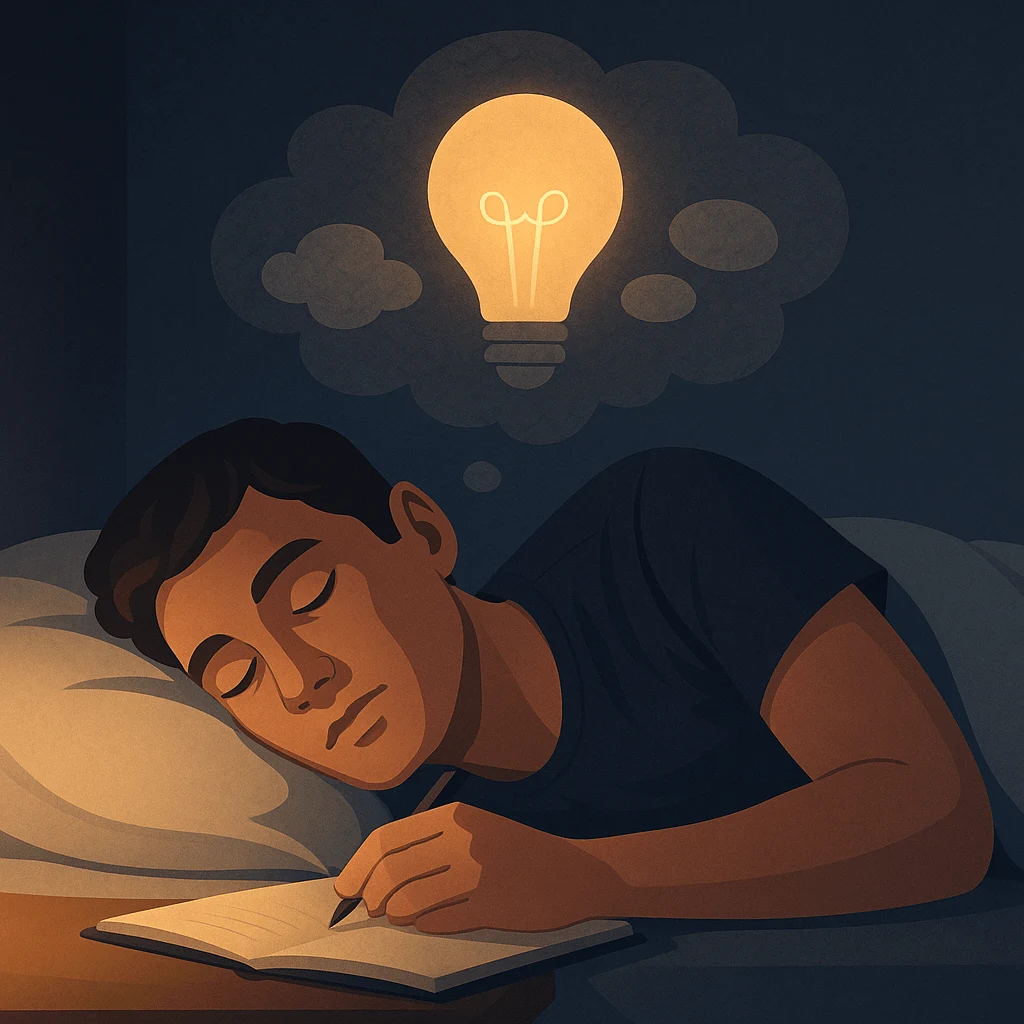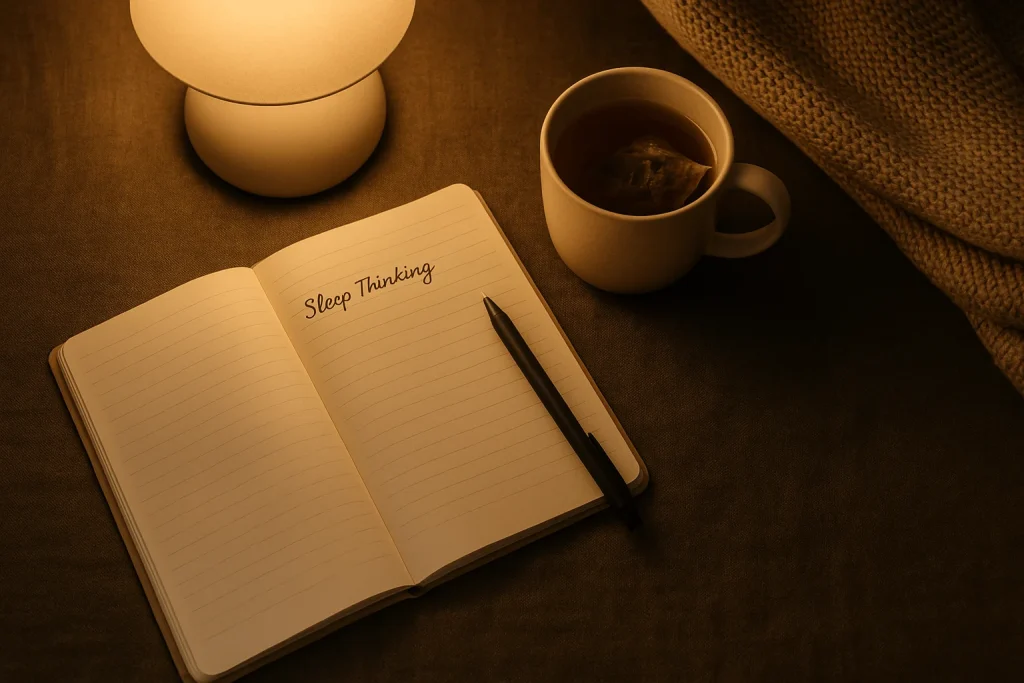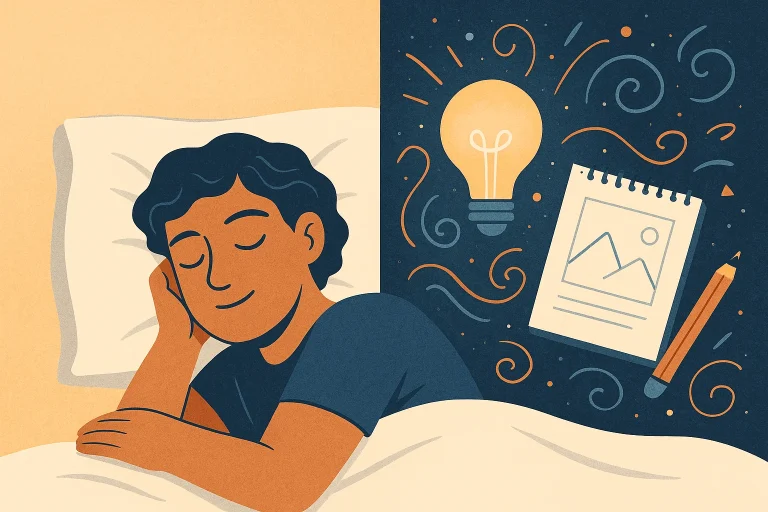How to Practice Sleep Thinking for Deeper Sleep and Insightful Mornings
What if your mind could keep working for you—even while you sleep?
Sleep thinking is a simple yet powerful technique that allows you to gently hand over problems, questions, or creative blocks to your subconscious mind. While your body rests, your brain continues to process, reflect, and explore—often bringing you new insights by morning.
In this article, you’ll learn exactly what sleep thinking is, how it works, and how to start using it. Whether you’re looking to ease nighttime stress, make better decisions, or spark creative ideas, sleep thinking can offer a practical, low-effort tool for personal growth and mental clarity.
Let’s explore how it works—and how to make it part of your routine tonight.
What Is Sleep Thinking and Why It Works
If you’ve ever gone to bed with a problem and woken up feeling clearer, you’ve already experienced the beginnings of sleep thinking.
At its core, sleep thinking is the practice of posing a simple, open-ended question to your mind before bed—then allowing your subconscious mind to reflect on it while you sleep. You’re not trying to dream the answer or stay consciously involved. You simply plant the seed and hand it over to your brain.
Sleep thinking taps into your mind’s natural processing ability during rest, especially in early sleep and REM cycles.
Let’s break down what makes this so effective.
How the Subconscious Mind Works During Sleep

Even while your body is resting, your brain is far from idle. During sleep—especially during lighter and REM stages—your mind continues to:
- Sort memories and emotions
- Strengthen neural connections
- Make unexpected associations
This is why you might solve problems in your sleep or wake up with creative ideas. Your conscious brain steps aside, and your subconscious gets to work without distractions.
Sleep Thinking vs. Dreaming: What’s the Difference?

Unlike lucid dreaming, sleep thinking doesn’t involve controlling your dreams. You don’t need to “watch” your dreams or remember them clearly.
Instead:
- You enter sleep with a question or area of reflection
- You allow your subconscious to process it freely
- Any clarity, ideas, or emotional shifts may come during sleep or upon waking
This makes it accessible to anyone, even if you rarely remember your dreams.
Why This Works: A Look at the Science
Studies in neuroscience and psychology show that the brain continues solving problems and consolidating ideas during rest. In fact:
- Sleep has been linked to improved decision-making
- People often perform better on creative tasks after a night’s sleep
- Memory recall and emotional regulation both improve with quality rest
In short: your subconscious mind during sleep is capable of more than we give it credit for.
Benefits of Sleep Thinking for Your Life and Well-being

Sleep thinking isn’t just a mental trick—it’s a practical tool that can support your mental clarity, decision-making, and emotional balance. Whether you’re facing a big life decision, feeling creatively blocked, or simply want to reduce stress at night, this technique can help.
Here are some of the key benefits you can expect.
Reduce Overthinking and Nighttime Anxiety

One of the biggest challenges people face at bedtime is a racing mind. When you intentionally guide your thoughts with a simple question, you shift from spiraling worry to focused reflection.
Instead of:
- “Why can’t I stop thinking about this?”
Try:
- “What’s one small step I can take tomorrow?”
This subtle change in how you approach nighttime thoughts helps your mind unwind instead of getting stuck.
Improve Creativity and Problem Solving

Creativity often thrives when you stop trying to force it. That’s where sleep and creativity go hand in hand.
When you sleep, your brain naturally explores new connections—especially around ideas you’ve been thinking about. Many inventors, artists, and writers have credited breakthroughs to the insights that came after they stopped thinking consciously.
Key Point: Your sleeping brain doesn’t get distracted by doubt or logic. That’s part of its creative power.
Gain Emotional Clarity Without Forcing It

Ever wake up feeling lighter, even though nothing external changed? That’s your subconscious working through emotions while you rest.
With sleep thinking, you gently encourage your mind to sort and soften emotional weight. You may wake up feeling more grounded or more at ease.
Make Better Personal and Professional Decisions
When you bring a real-life decision into sleep thinking—like whether to change jobs, shift routines, or resolve conflict—you’re not demanding answers. You’re giving space for insight to emerge.
People who practice this often find they:
- Make calmer, more thoughtful choices
- Feel less mental “fog” around decisions
- Trust their gut instincts more
Don’t expect dramatic “aha” moments every time. Often, the benefit is subtle but steady—a growing sense of direction.
Related Post: 7 Powerful Breathing Exercises for Better Sleep
How to Practice Sleep Thinking: A Simple Nightly Routine

You don’t need any special tools or techniques to start sleep thinking. All it takes is a few minutes before bed and a willingness to let go of control.
Here’s a simple, repeatable routine that helps you guide your subconscious mind during sleep—and activate its quiet problem-solving power.
Step 1 – Choose a Calm, Open-Ended Question
Think of something you’d like insight on—a decision, a feeling, or a goal. Keep the question light enough that it won’t trigger stress.
✅ Try questions like:
- “What would help me feel more focused tomorrow?”
- “What’s holding me back from moving forward?”
- “How can I communicate more clearly with [person]?”
⚠️ Avoid questions that feel emotionally intense or pressuring, like “Why am I failing?” These can activate worry instead of reflection.
Step 2 – Write the Question Down
Use a notebook or notes app to jot your question clearly. This helps shift it from your conscious mind to your subconscious.
Writing anchors your intention and gives your brain a clear prompt to carry into sleep.
No need to write a paragraph—just one clean sentence will do.
Step 3 – Read It Aloud and Release the Thought
Right before sleep, read the question slowly and calmly. There’s no need to solve anything—just invite reflection.
You might say to yourself:
“I’m giving this to my deeper mind tonight. Whatever clarity I need will come.”
Then relax and sleep. No overthinking
Step 4 – Reflect Briefly in the Morning
Spend a minute in the morning checking in. This is when subtle ideas or feelings often surface.
✅ You might:
- Jot down a word, emotion, or image
- Notice if your view of the question feels different
- Capture any fresh ideas, no matter how small
Not every morning brings an answer—but often, something shifts quietly under the surface.
Common Mistakes to Avoid When Trying Sleep Thinking

Sleep thinking is simple—but easy to misapply if you’re new to it. Here are four common pitfalls to watch for—and how to stay on track.
Mistake #1: Expecting Instant Results
Don’t expect a dream or perfect solution overnight. Sleep thinking often works in subtle, gradual ways.
Insights may appear as changes in your mood, clarity, or decision-making—not dramatic moments.
✅ Give it a few nights before judging. Look for shifts, not epiphanies.
Mistake #2: Asking Heavy, Stressful Questions
Questions that spark anxiety can keep your brain in alert mode, blocking restful processing.
✅ Reframe with curiosity and care. For example:
- Instead of “Why do I always mess up?”
- Ask “What helps me move forward when I feel uncertain?”
Mistake #3: Skipping Morning Reflection
Your brain may offer you a quiet clue—an image, a phrase, a feeling. But without a pause, you’ll likely miss it.
✅ Set aside just one minute to note what comes up. Even faint impressions matter.
Mistake #4: Overstimulating Before Bed
If your mind is overloaded with screens, work, or stress, it won’t settle into reflection mode.
✅ Create a 20-minute wind-down buffer. Dim lights, stretch gently, or read something light—then pose your sleep thinking question.
A Simple Habit That Lets Your Brain Solve While You Sleep
You don’t need to push harder, analyze more, or stay up late trying to figure everything out. Your mind is already equipped to help you process, reflect, and solve—even while you sleep.
Sleep thinking is about using that natural process with intention. By asking a thoughtful question before bed and giving yourself space to notice what surfaces in the morning, you activate one of your brain’s most underrated abilities.
If you’re just getting started, try this tonight:
- Pick one calm, curious question
- Write it down
- Read it slowly
- Release the thought and rest
Then tomorrow, take a minute to check in. Insight often begins quietly—but it builds.
Frequently Asked Questions
What is sleep thinking in simple terms?
Sleep thinking is the practice of asking your mind a question before bed and allowing your subconscious to explore it while you sleep. You may wake up with new ideas, clarity, or a lighter feeling.
Can anyone try sleep thinking?
Yes—no special skills or experience needed. You don’t need to remember dreams. Just set an intention and reflect briefly the next day.
What kinds of questions work best?
Stick with simple, open-ended prompts like:
- “What would help me feel more confident tomorrow?”
- “What’s one small step I can take this week?”
Avoid stressful or urgent questions.
Do I need to write the question down?
Writing helps—your brain recognizes it as something to pay attention to. A quick note makes it more likely you’ll remember and reflect.
What if nothing happens?
That’s normal at first. Sleep thinking often brings subtle changes. Keep going for a few nights, and observe any shifts in how you feel or think.







